You have an interesting story and you know how to tell it; the trick is spreading the story to a wide audience
In the first installment of our series on public relations for the club racer, our experts spoke about making your story compelling and also making sure you have the skills to tell it. Once you have those in place, it’s time to get your story to a wide audience – which isn’t easy.
“There are only so many places that a person in our little ecosystem of club racing can be written about,” notes Efrain Olivares, Mazda Motorsports PR. “Only so many magazines, so many Web sites. There’s been a contraction of the number of journalists and media covering anything, let alone something relatively small like auto racing – and then slice that pie even smaller into club racing. What that means is if you want to be the sort of person that’s top of mind [for a journalist to talk to], you need to build relationships. You need to actually go out of your way to seek these people out. You need to find a way to meet them, let them understand who you are and, frankly, just be likable. And be someone who’s quotable.”
What Olivares is citing is positioning yourself as someone who not only understands a subject but can talk about it eloquently. In the process, you will get exposure for yourself and your sponsors. It’s a way to tell your story indirectly. Olivares mentions something along the lines of a journalist writing about unlocking the secrets of a certain racetrack. Well. if he or she met you at that track, and you had a good win there that day, you’re going to be the person that springs to mind when thinking about sources for that story.
As Olivares notes, the media pool is shrinking and the number of outlets that specifically center on racing is small. But what about media that doesn’t cover racing? Perhaps a trade magazine for the industry of a sponsor is an outlet worth pursuing.
“In the case of a driver concerned about raising his profile for sponsors that are already signed on, who’s the audience that’s important for that sponsor,” asks Matt Cleary, owner of Sunday Group Management that provides public relations services for Idemitsu Mazda MX-5 Cup presented by BFGoodrich. “If it’s a pool cleaning supply company, where would a pool cleaning supply company advertise or have articles written about that industry? Is there a way to pitch them about a story that also happens to be about supporting a race car driver? Figure out what the audience is and then try to find the bridge to connect them.”
If your target is general media – a local paper, or even a high school or college media outlet – then be prepared. And don’t use communication methods that are easily ignored.
“It’s easy to send an e-mail, and it’s easy to ignore an e-mail,” says Olivares. “What is not easy for young drivers is to speak in person. If you want to get attention from your local paper, your college paper, or a trade publication, it’s going to be much better if you can find a phone number and make the call. You need to be the type of person that’s comfortable making calls and anticipate that you’re going to get the person on the phone right away. Get your pitch ready. Be ready sell them inside of 30 seconds as to why your story is unique, and anticipate their questions. It’s like having your car prepped before you show up at the track; it’s going to go much smoother if you’ve done the work beforehand.”
The same is true for actually talking to journalists. Maybe your pitch worked and the writer wishes to interview you right then, or maybe a writer is at the track doing a story on amateur racers and he or she wants to interview you after you’ve won a race. Whatever the question, “Yes,” “No,” or, “Racing is fun,” are not the answers they want.
“From a cognitive point of view, the drivers need to think about what the journalists are trying to get,” explains Cleary. “What’s the output he’s trying to reach by talking to you? Chances are he already knows what 80 percent of the answer is, but the driver has to say it. The driver has to be cognizant of what the journalist is trying to do.”
In the third installment, we’ll talk about another form of public relations: direct communication, including social media. And be warned, it’s a minefield!


 ACCESSIBILITY
ACCESSIBILITY